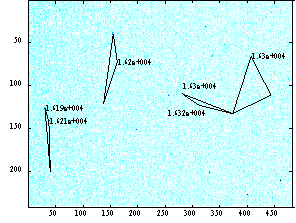Star IdentificationBackgroundAn in-space star-pattern identification capability is becoming an increasingly important aspect of spacecraft navigation. It has been specified as an attitude system requirement for several forthcoming missions, including Proteus, Rosetta and Cassini. The ability to recognise stars autonomously and to determine spacecraft attitude greatly enhances the value of star-camera data and has many advantages. Spacecraft designed with this inherent autonomy are less reliant on expensive and fragile ground communication links, are more robust against system failure, require fewer sensors and have higher pointing-accuracy capabilities. Autonomous star-pattern identification may be of particular benefit to deep-space missions where communication delays make interactive decision-making inefficient and time consuming, contributing to a significant portion of the overall mission cost. Despite these advantages, few commercially available star-camera systems with an autonomous star-identification capability have been developed to date. The techniques and methods of those few systems in existence are highly experimental, and the development of reliable identification strategies is an active area for research. Research into Rapid Autonomous Star-Identification TechniquesI have worked to develop a new star-identification strategy capable of identifying stars in a single camera image with minimal processing. The system attempts to identify groups of stars by comparing their features to those in a pre-stored catalogue. Although this general approach is not new, particular methods of processing raw star-camera data, of choosing star groups and features and of encoding the catalogue, provide new and innovative advances in autonomous star recognition. These new approaches offer significant performance advantages over existing technologies. My research includes work on fast, non-sequential search techniques. The algorithm dramatically reduces the number of comparisons required to make an identification by implementing a divide-and-conquer strategy based on a binary tree search technique. With knowledge of star-camera observation accuracies, a search algorithm can be constructed so that the correct star will always be identified, if not uniquely, then to within a small set of possibilities (assuming that the features are correctly identified). Not only does this approach offer the possibility of real-time star identification, it also expands the range of star-cameras suitable for adaptation to autonomous attitude determination to include high-accuracy, narrow field-of-view star cameras. Previously, the size of the required reference catalogues has made star identification from narrow fields of view impractical. The new non-sequential search strategy allows identification matches to be made from catalogues of 50000 stars or more in minimal time with low storage requirements. Figure 1 shows a star-identification example. A CCD camera image of the sky is shown, overlaid with triads of stars identified by the system. The star-identification technique dramatically enhances the value of the star-location data generated by the camera, for attitude determination.
Figure 1: Star Identification of Triads of Stars From Star-Camera Frames. An autonomous star identification processing system that exploits these aspects of my research is currently being developed by Matra Marconi Space U.K., in conjunction with star camera head manufacturers. Further information describing this research can be found here. Links to Other Star Identification SitesThere are a number of web sites describing autonomous star identification systems. Most other techniques use separation features to make matches and use two modes: a slow initial identification mode and a faster track stars mode. These include in no particular order:
|
